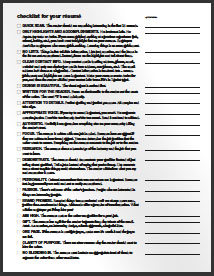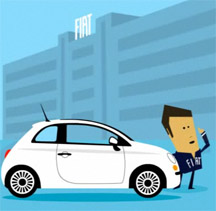Indifferece was the focus of a recent presentation from Martin Weigel, head of planning at Wieden + Kennedy, Amsterdam. The presentation was one of the weekly Friday Forums at the VCU Brandcenter… always rich with inspiration. Here are Weigel’s ways to defeat indifference along with some of my thoughts thrown in:
Most consumers will not care about your client’s product. For most brands half of all sales come from 20% of the consumers. So that means half of all sales come from people who are indifferent about the brand.

Many advertisers try to overcome indifference by making ads bigger, brighter, and flashier. But consumers are getting better and beter at ignoring those ads.
Weigel says that the conventional wisdom is that 80% of brand’s sales come from 20% of the customers. The 80/20 rule does not exist for the vast majority of brands. Weigel says that the accurate ratio is 50/20. This is counter to many experts’ thoughts about the influence of brand loyalists. However, the numbers don’t matter (for this discussion). What matters is getting people to care.
Q: How do we get people to at least mildly care about the client’s brand? How do we defeat indifference?
A: Engage the audience with natural human instincts — primitive creature impulses. When we strip out all of the demographic and psychographic data, consumers are beings that react to stuff – like all living things do.
Weigel says that brands need to “stir” consumers’ emotions.
In The Persuaders (a great PBS documentary), Coltaire Rapaille says that brands need to go deeper than just appealing to emotional needs. “All purchasing decisions really lie beyond conscious thinking and emotion,” says Rapaille. He says purchase decisions reside in “a primal core” — the reptilian brain. “When we [are] born, we have the reptilian brain.” The reptilian brain is where the first reaction to things takes place, before emotions.
Back to Weigel’s great presentation. Weigel says that brands need to use these four tools to defeat indifference:
– Beauty
– Immersion
– Transformation
– Shock
Beauty: Humans seek out patterns naturally. Beauty is seeing the world so that everything fits and everything has consequence. For an intellectual illustration of this, Weigel reminded us of Einstein’s Theory of Relativity. Less-abstract examples are the work of everyday artists, architects, and designers. They all try to get things to fit appropriately into the contexts of time and space. Beauty has a way of bypassing critical and rational thinking. It persuades us to act on our emotions and to make impulse decisions. Many studies have shown that beauty, pattern, structure, and order add perceived value. Weigel concludes that “beautiful brands are stronger than unorganized, random brands.”
Immersion: To get lost in the moment and to be part of something bigger. Weigel gave examples of Burning Man, sex, music, and intoxication. Professional sports teams do a good job of making their fans feel like they are part of a bigger cause. I’d say that many colleges do that, too (but VCU has some room for growth in this area). Immersion is turning “I” into “we.” Nike Plus is a great example of that. Another good example is the wonderful cause marketing efforts like Yoplait and their work with several social causes (like the Susan G. Komen for the Cure). The success of Toms Shoes (and many other cause-related brands) proves that when a company becomes a cause, consumers care about them. This also reminds me of the article about “creating fashion” – when a brand offers the customer a sense of identity. Think about Harley-Davidson, political parties, and religions. And speaking of religions, it’s not a coincidence that baptisms are an immersion (figuratively and literally).
Transformation: The promise of change. Barak Obama won the 2008 election by evoking the emotion of transformation. Walmart’s old message was all about low prices and slashing prices. And they did very well with that strategy. But their new strategy is much stronger because it takes the fact of low prices and makes it transformative: Save money. Live better. The “Save money” builds off of the equity they had established. The “Live better” connects Walmart to a transformative emotion, and makes people feel better about Walmart.
Brands are stories. Good stories (from the beginning of time) have always been about triumph over conflict: transformation.
Shock: Freshness and originality. Weigel says there are two methods of shock: 1) The shock of new, and 2) The shock of recognition. The shock of the new goes along with surprise, especially sudden surprise. When Mini Cooper came out, they connected to consumers with the shock of new. Hummer did the same thing… in a very different way.
The shock of recognition is produced by uncovering things that were always there. Many comedians build nice careers by reflecting back people’s funny situations to them: “What was the deal with the hairstyles of the 90s? What were we thinking?!” While the shock of new is quick, the shock of recognition usually builds a little slower.
Apple uses shock to connect with consumers by turning them on with cool, new products. There’s a quick attraction to the newness of Apple’s neat innovative products. Apple also uses simplicity to create a slow-building emotional attraction similar to the shock of recognition.
Shock creates stimulation, and that causes our brains to release dopamine. Dopamine is connected to the brain’s reward and pleasure centers. Weigel says, “We crave dopamine.”
To battle indifference, we need to make others care. We need to look at the things that humans crave all of the time, and give it to them: beauty, immersion, transformation and shock. If we’re successful, it will inspire consumers to come toward the brand (not back away from it). It will inspire consumers to share the brand with others – automatic word-of-mouth promotions. And if we wipe out indifference, it will change how ads are perceived and received. Ads won’t be something that interrupts the audience; ads will be welcome. To illustrate the last point, look on YouTube to see how many great ads from this week’s Super Bowl have over a million hits. these are ads that have broken through the indifference barrier.
I wondered what others were saying about indifference. After a quick online search of quotes about indifference, I found this from Elie Wiesel, a Holocaust survivor, Nobel Laureate, writer, political activist, and college professor. “The opposite of love is not hate, it’s indifference. The opposite of art is not ugliness, it’s indifference. The opposite of faith is not heresy, it’s indifference. And the opposite of life is not death, it’s indifference.” Wiesel also said, “Nothing good can come out of indifference. In fact, nothing can come out of indifference.”
To battle indifference, we need to make others care. For Elie Wiesel it’s getting people to care about each other and to make the world a better place — a noble cause. For Martin Weigel it’s getting people to care about brands. Not as noble, but still very difficult.
Filed under: Advertising, Creativity | Tagged: Advertising, Brandcenter, indifference, Martin Weigel, Scott Sherman, Strategy, teaching, VCU | Leave a comment »












